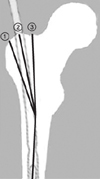Abstract
Purpose
Materials and Methods
Results
Conclusion
Figures and Tables
Fig. 1
For estimation of proper entry portals, we assumed the length of Sirus® nail (s) to circular arc (EF). The radius (r) of the circle was informed by regular manufacturer's information. Finally we estimated the central angle (θ) from the circle and compared with contralateral neck-shaft angle.

Fig. 2
Illustration of subdivision by entry points. ①: Lateral entry point, ②: greater trochanter tip entry point, ③: medial entry point.

Fig. 3
Preoperative and postoperative antero-posterior view of iatrogenic fracture that occurred in Sirus® nail insertion using lateral entry point.

Table 2
Comparison of Clinical Results and Complications between Subtrochanteric and Shaft Fracture of the Femur

Values are presented as median (range) or number (%). *Includes screw irritations, heterotrophic ossification, device loosening & breakage and limping gait with pain. †Mal-alignment was defined as more than or equal to 5 degrees of neck-shaft angle compared with contralateral of the subtrochanteric fractures in the coronal plane and 10 degrees of total angular deformity of the femoral shaft fractures in the coronal and sagittal planes, respectively.
Table 3
Comparison of Clinical Results between Entry Portals (n=36)

Values are presented as median (range) or number (%). *Includes screw irritations, heterotophic ossification, device loosening & breakage and limping gait with pain. †Mal-alignment was defined as more than or equal to 5 degrees of neck-shaft angle compared with contralateral of the subtrochanteric fractures in the coronal plane and 10 degrees of total angular deformity of the femoral shaft fractures in the coronal and sagittal planes, respectively.




 PDF
PDF ePub
ePub Citation
Citation Print
Print



 XML Download
XML Download